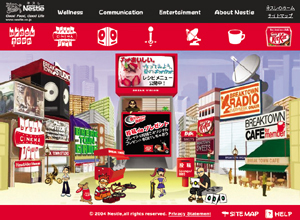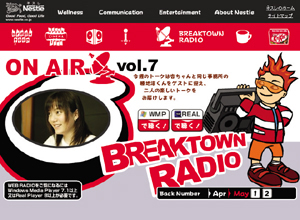Upfront: Navigating the New Media
Back to Contents of Issue: August 2004
|
|
|
|
by By David Kilburn |
|
 Television has been at the heart of major advertising campaigns for over 40 years. And since its inception, no better way has been found to convey simple, motivating messages to the multitudes.
The growth of brands and the development of marketing itself owe much to this pheno-menon. In 1987, television advertising enabled Kao's innovative compact detergent, Attack, to dominate Japan's laundry market within weeks. Television also promulgated the new taste of Asahi Super Dry, turning around the fortunes of Asahi Breweries and transforming Japan's beer market. Like Sony's Walkman, both brands offered benefits that met needs and would have done well anyhow, but television advertising fast-tracked them to success.
Broadcast television's glory days may be coming to an end. Today, there are so many more ways to connect with consumers, including satellite, cable, the Internet and I-mode. More channels and more choices lead to smaller audiences. Thus it is not surprising to hear seasoned marketers like Procter & Gamble Far East's president Werner Geissler note that "the communication landscape splinters further and further. TV will most likely play a less important role. Twenty years ago it took three spots to reach 80 percent of your target group. Today, in Japan, it takes over 20 to create the same awareness among the same group of people."
Two revolutions are taking place. Soon, the concept of a 'channel' will be meaningless. There will be infinite channel capacity and viewers will be able to choose not only what content to view, but whether to do so on their TV screens, laptops, mobile phones, PDAs, electronic books, or even to buy a ready printed copy. They will also be able to choose to view now or later.
The second revolution is that advertisers can learn more about their customers than ever before. Some data will come via software that surreptitiously tracks their habits, but most will come directly from consumers who trade personal details for access to interesting or useful content. At least some of the time, advertisers will be able to address large numbers of consumers as individuals.
One glimpse of the future can be found at www.breaktown.com, where J.Walter Thompson Japan and Funny Garbage have created an online experience for Nestle's confectionery brand Kit Kat. The site shows trendy young Japanese characters and their adventures in an imaginary world called "Breaktown." The site was created to generate buzz and excitement among the young Japanese at the core of Kit Kat's consumer community. Amidst the fun and entertainment, there are interactive quizzes and marketing surveys integral to the narrative that seamlessly collect customer data, including demographic information and product preferences.
But for now, and for as long as the TV broadcasters continue to craft the dramas, soaps and entertainment programs that engage viewers so effectively that they schedule their days around them, television will remain the leading source of entertainment for many people.
True, the days of family viewing are over--today people watch their own favorite programs on their own TV sets. In the same way, the days when only one brand of beer could be found in the fridge and only one brand of shampoo in the bathroom have passed into history. Audiences are certainly more fragmented, just as product choices are much broader and individual preferences more diversified than a generation ago.
The real issue in Japan is not the declining power of television, but rather the quality of audience research data that the broadcasters provide. For reasons best known to themselves, the broadcasters still sell airtime based on household ratings. In a household where three people are watching their own individual TV sets, each scores as a household rating. Media agencies such as Universal McCann and Mindshare Japan now have software tools that enable them to deconstruct the packages of airtime based on household ratings that the broadcasters sell. This enables them to discover what value they really hold. "If they wanted to find a way out of the doldrums in advertising sales, the TV broadcasters should unbundle household ratings and sell target [individual] ratings, as in other markets. Then you are really focusing the attention on the audience and the value of that audience at different times of day," says Ron Pullem, executive vice president of Universal McCann.
There is still enormous power in television advertising in Japan, but it will be on a tight rein while traditional practices of the industry remain unchanged. To navigate today's landscape of media opportunities, creativity and a grasp of media planning technologies are crucial--two reasons why approaches to media pioneered in Europe and more recently in the US are gaining ground in Japan. @ |
|
Note: The function "email this page" is currently not supported for this page.






